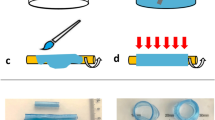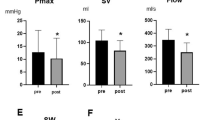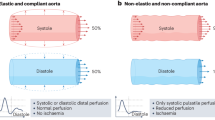Abstract
THE human aortic valve consists of three cusps made of relatively inelastic, muscle-free material about 0.15 mm thick. It opens and shuts about once a second, and withstands a pressure difference of 100 mm of mercury when closed. It usually functions for 70 yr without failure, and works so efficiently that very little blood is regurgitated at each pulse. In order to support this large pressure difference, the cusps must close simultaneously in all operating conditions and should not touch the wall of the aorta, for considerable reversed flow would then be required to close the valve. This action suggests a fluid dynamic control mechanism which positions the cusps away from the wall of the aorta, so that the slightest reversed flow will close the valve.
This is a preview of subscription content, access via your institution
Access options
Subscribe to this journal
Receive 51 print issues and online access
$199.00 per year
only $3.90 per issue
Buy this article
- Purchase on Springer Link
- Instant access to full article PDF
Prices may be subject to local taxes which are calculated during checkout
Similar content being viewed by others
References
Keele, K. D., Leonardo da Vinci on Movement of the Heart and Blood, 81 (Harvey and Blythe, Ltd., London, 1952).
Author information
Authors and Affiliations
Rights and permissions
About this article
Cite this article
BELLHOUSE, B., BELLHOUSE, F. Mechanism of Closure of the Aortic Valve. Nature 217, 86–87 (1968). https://doi.org/10.1038/217086b0
Received:
Issue Date:
DOI: https://doi.org/10.1038/217086b0
This article is cited by
-
Restoration of flow in the aorta: a novel therapeutic target in aortic valve intervention
Nature Reviews Cardiology (2024)
-
Über die Aortenklappe – von Leonardo da Vinci bis heute
Zeitschrift für Herz-,Thorax- und Gefäßchirurgie (2024)
-
Semi-Automated Construction of Patient-Specific Aortic Valves from Computed Tomography Images
Annals of Biomedical Engineering (2023)
-
Bicuspid aortic valve morphology and hemodynamics by same-day echocardiography and cardiac MRI
The International Journal of Cardiovascular Imaging (2022)
-
Assessing the Thrombogenic Potential of Heart Valve Prostheses: An Approach for a Standardized In-Vitro Method
Cardiovascular Engineering and Technology (2019)
Comments
By submitting a comment you agree to abide by our Terms and Community Guidelines. If you find something abusive or that does not comply with our terms or guidelines please flag it as inappropriate.



